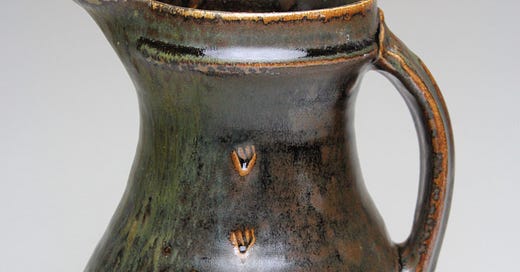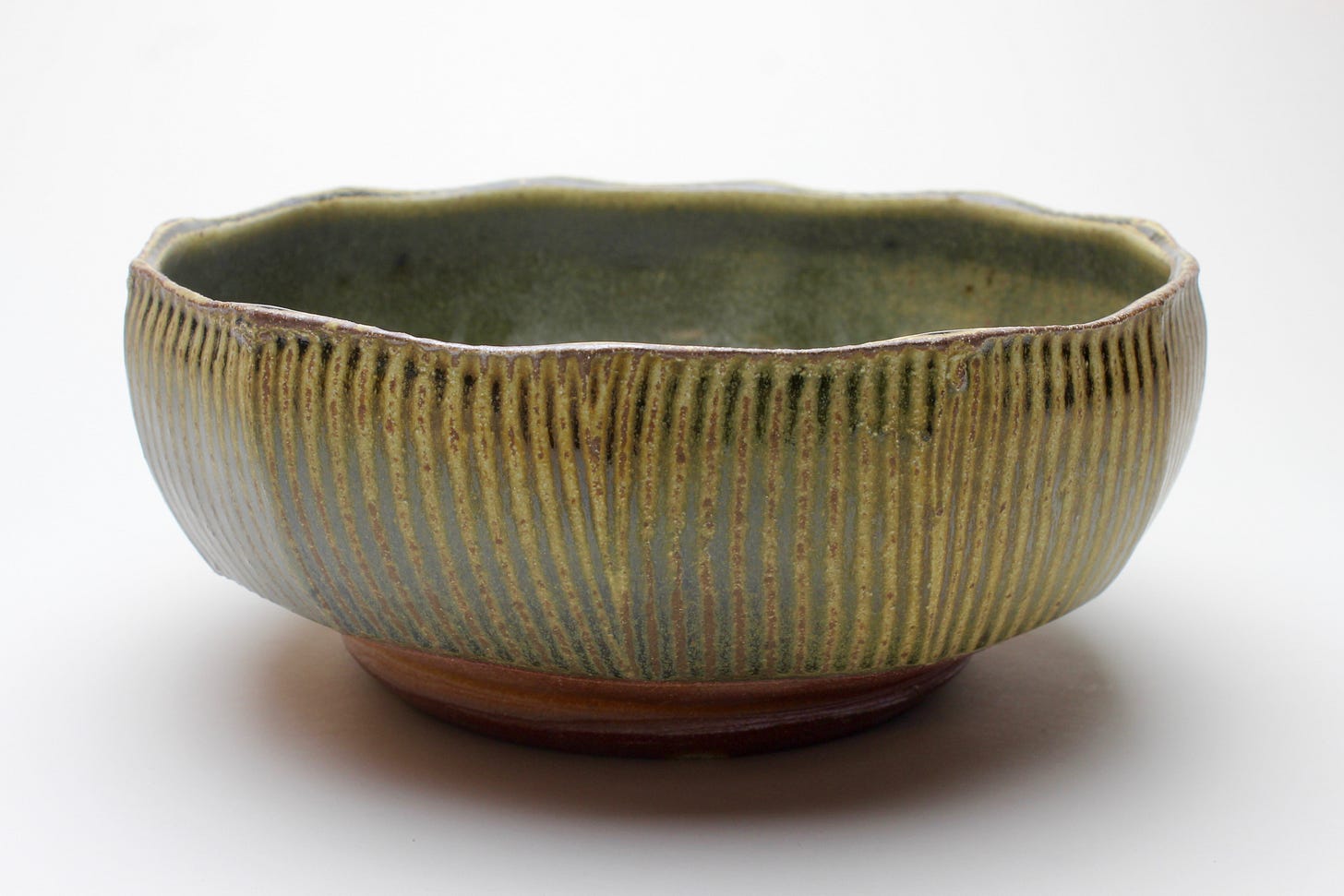How Surfing Potters and Sunday Fish Fries Inspired a Potter’s Artistry
The Story of Joe Bennion and Horseshoe Mountain Pottery ~by Tamara S. Wolfe (published in the My Local Utah online business community)
It was a chilly shimmery autumn day in Spring City, Utah. I lifted my ‘cup of Joe’ to enjoy a few sips at Das Café before heading down Main Street to Horseshoe Mountain Pottery, not yet realizing this warm brown lustrous mug holding my morning wake-up was made by Horseshoe’s owner, ceramist Joe Bennion.
As soon as I stepped into Horseshoe, the mug’s connection took shape as one of the shop’s shelves was brimming with similar works of art. I waved to Joe who was sitting near the back, spinning his clay into a dinner plate on the same wheel he’s been connecting with for 43 years. What then unfolded was a story with as many unexpected turns as each time Joe evolves one of his uniquely beautiful creations…
Joe grew up next door to his Uncle George who had three children who loved to work with clay. They had a pottery studio in their basement and a kiln. Joe was constantly in and out of their home, watching them work with clay and thinking this is something he may want to do. However, when Joe entered Brigham Young University, he fell into following the path of much of his family, studying early childhood education to become an elementary school teacher.
But then the summer of 1974 happened…
Joe illuminates…
I was up in Northern California working in a logging operation to earn some money when I found myself with more time on my hands than I thought possible due to work stoppages. I ran into Mike and Harley, a couple of potters who owned a ceramic studio in Crescent City and I asked them if I could do some pottery work. They let me hang out and I kind of became their mascot ⎼ I was this squeaky clean young man from Utah and they were classic West Coast hippies so I was a novelty of sorts.
Their studio consisted of a boxcar propped up on blocks. And their pottery wheel was made from a Maytag washing machine motor mounted on a steel frame with a Chevy 3-speed car transmission to change speeds and a wooden wheel head. It was very inventive but primitive compared to the equipment we have today. Back then, there were not very many wheel manufacturers around. And Mike and Harley came up with this wheel, and it was pretty cool.
They would get up early and make pottery until about 12 noon, then slip on their wetsuits and go surfing, leaving me to mess around in the studio. They gave me assignments like cleaning the kiln shelves, repairing the chimney, and mixing clay. In the evening they would return to check on their pottery, then head out to play blues and rock and roll at a roadhouse on Highway 1. On Sundays, they traded pottery for fish down at the docks and then held a big fish fry served up on the stoneware they made. Every hippie in Del Norte County showed up to savor homemade beer, wine, salads, breads and cheese, along with heaps of fried fish and music.
I soaked in the entirety of my time with Mike and Harley and thought… This could really be the life. There was a freestyle rhythm to the way they lived each day, and it turned out to be the greatest influence on my life.
For Joe, those Sunday fish feasts offered much more than just a meal. They were a place where everyone was welcome, where the community gathered, and where the symbiotic relationship between food and pottery, and friends and family, became central to his artistry. He formed an ethic and made a promise ⎼ he would make pottery whose purpose was to serve up nourishment and memories in the kitchen, at the table, and among people wherever they gathered. And Mike and Harley’s daily tradition of catching the waves has beckoned Joe to do the same ⎼ for years he has been dividing his time between his craft and running rubber boats with his wife Lee, down the white waters of the Grand Canyon river.
In the fall when Joe returned to BYU, he decided to take the road less traveled and entered the ceramics program. Soon thereafter, he began pursuing a Masters in Fine Arts when he suddenly hit headlong into a roadblock. A faculty bias against the utilitarian pottery he so loved to create stranded him on the brink of being dropped from the MFA program if he continued to make his chosen art form.
That is, until Ceramics Monthly came along…
In Joe’s words...
I was in San Antonio at a big ceramic educators conference, when I met Bill Hunt who was the editor of Ceramics Monthly magazine, one of the biggest pottery platforms in the world. I had the chance to show Bill a sheet of 20 transparencies of my work. He said, ‘I really like what you are doing.’ And he asked me to send him some 3” x 5” transparencies of my work.
I came home and withdrew $600 from the bank which was a lot, as I was a student living on fumes. But I found a student in product photography to shoot several pieces of my work and I submitted 3” x 5” transparencies to Ceramics Monthly, along with some black and white prints and descriptive content. I waited and waited and waited, for a page or two to show up. But when I opened the December 1986 Issue of Ceramics Monthly, Bill had given me a seven page spread, five of which were color and two black and white. It was remarkable.
The next time I met with my graduate committee, I had the seven page spread in hand which, in essence, was my entire graduate show artfully displayed in a magazine. And the committee conceded that I should get my MFA degree. So, I owe a lot to Bill who has since retired but remains my dear friend to this day.
After the spread in Ceramics Monthly, it seemed as if everyone wanted Joe to visit their school and teach. He accepted an invitation to conduct a two week workshop at Pewabic Pottery, a ceramic studio and school in Detroit, Michigan. The woman who had hired him imparted the kind of observations and wisdom Joe will never forget…
She shared that my art really speaks about utility, and the quietness of pottery that’s used in everyday life. She could see what I was conveying through my work. And she told me: ‘Don’t look behind you, don’t look to the left, don’t look to the right, and don’t look at what’s selling in the boutiques and galleries. Just look at what people need and stick to your guns and you will find your niche. You will find your market. Don’t make your work to fit an existing market.’
Destined for Spring City…
Joe and Lee sought the same kind of quietness that emanated from his artistry in an area where they could raise their family. So, in 1979 they moved to Spring City and in 1980 they opened Horseshoe Mountain Pottery.
Joe describes..
It’s the quiet I love about this place, in cadence with the sounds of the local animals. Once in a while you hear a dog barking, and in the morning you hear alot of roosters crowing. You can still hear cattle off in the background or a donkey braying. It’s a peaceful life.
A far cry from my boyhood days when I loved playing with matches and accidentally lit an abandoned cherry orchard on fire. I found myself arrested at the ripe old age of eleven. But you know, my passion for fire has now been shaped into my pots. The wood burning kiln I own shoots up this massive fire where I am required to stoke and prod it to produce the perfect heat for bisque firing my ceramics and finishing them with glazes of warm rich colors. Firing up that kiln is kind of my legal way to stay out of trouble and still enjoy those brilliant flames.
And from those flames has arisen the most artful works of utilitarian pottery, catching fire with both the local folks and those who travel across the country to purchase a box full of Joe’s pottery…
Every customer can count on Horseshoe’s door to always be open, even when Joe and Lee are away for weeks, guiding rafts down the river. Joe just leaves a giant jar to drop cash or checks into, and a sheet to hand record each purchase. But even when Joe is absent, every customer can still feel the presence of his hands and tools and fire that have shaped and shined each work of art. This kind of connection cannot be manufactured. Rather, it’s the raw genuine kind born from long ago in that summer of ‘74 when a couple of potters in Crescent City made Joe a part of their everyday life.
If you are in Spring City, stop by Horseshoe Mountain Pottery located at 250 S Main St, Spring City, UT 84662. Say hello to Joe, and consider making his utilitarian ceramics a part of your home.
You are currently a free subscriber to Stories of the Uncommon Artist. To enjoy the full experience of our community, please consider upgrading your subscription. Thank you.







Thanks for capturing just the tiniest portion of all that is Joe Bennion. He's a remarkable man. I'm pleased to see you'll be doing a story on Lee. She is equally amazing and fascinating. I'm grateful for their friendship and enjoy visiting Spring City twice a year to replenish my soul.
I own probably twenty pieces made by Joe. I love them, every one.